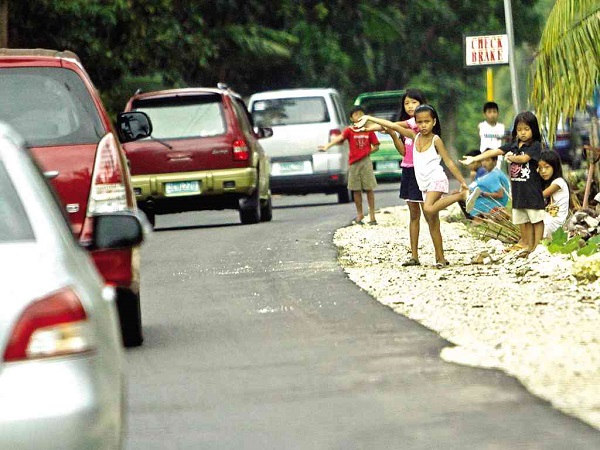
CHILDREN in northern Cebu ask motorists for donations in kind or in cash. LITO TECSON/ CEBU DAILY NEWS
BORBON, Cebu—Eight-year-old Jomar stretches out an open palm to beg for food or money along the national highway in the municipality of Borbon in northern Cebu province. Later, he and four other youngsters will sit on a fallen tree branch for a break while waiting for more motorists to pass by.
“We ask for food so that we will have something to eat. Some motorists give coins. I save it and give it to my mother,” Jomar says in Cebuano.
The boy wants to help his widowed mother earn money so they can replace the nipa roof of their hut that was blown away by Supertyphoon “Yolanda” on Nov. 8.
Private donors had earlier given them used tarpaulin for roofing material. Old wood pieces from the debris prop up the single-room shanty.
Before Yolanda, Jomar and the other children did not know anything about begging. Now, they see it as an easy way to get a few pesos from kindhearted motorists.
Borbon, a fourth-class municipality (annual income:
P25 million-P35 million, population: 32,000) located 82 kilometers north of Cebu City, is among Cebu’s northern towns that were badly hit by Yolanda. These included Bogo City, Tabogon, Medellin, San Remigio and Daanbantayan towns, all in mainland Cebu, and Sta. Fe, Bantayan and Madridejos towns on Bantayan Island.
The typhoon destroyed or damaged about 1,000 houses in Borbon, affecting nearly half of the residents, according to its mayor, Butch Sepulveda.
The municipal government has provided the survivors three batches of relief items— 3 kilograms of rice, canned goods and noodles. They also received relief aid from the provincial government, the Department of Social Welfare and Development and private donors.
Sepulveda said the municipal government was in the process of acquiring construction materials worth at least P1 million in calamity fund for distribution to the families.
“There are just those who do not get contented. They want to ask for more,” he said.
The mayor is unhappy with the way the children have turned out, especially with the danger they are risking. A week ago, he was told of an unidentified child who was sideswept by a passing vehicle.
“They are not really beggars. They are just people taking advantage of the situation to get food and money. I am asking the passersby not to give anymore so they will already [stop],” Sepulveda said.
Policemen have been sent to stop the children from begging, but they only run to their parents or hide. “They just hide for a while and go back to the streets when the police leave,” the mayor said in Cebuano.
The number of beggars started to grow when they saw that private vehicles delivering relief items would stop along the highway and share with the milling crowd some of their cargo.
On Nov. 24, reporters who visited northern Cebu saw children and women crowding portions of a 30-km stretch of the north road in Sogod town, Borbon, Tabogon town and Bogo.
They held out their hands to beg, while some children would rub their bellies with their hands or point to their mouths to gesture hunger.
One boy drew with a pen a cartoon with the message “Hatagi ko ug pagkaon (Give me food).”
Bogo administrator Carlo Fernando Logarta said the beggars near the boundary of the city were from neighboring towns. “People in our city do not have to beg because the city government made sure that they were well fed,” he said.
The city implemented a P2.5-million food-for-work program on Nov. 11-16, hiring 2,200 people for P150 daily so they could earn money to buy nails and other housing materials.
In the case of Borbon, Sepulveda said that because of scarce resources, the municipal government was limited only to giving out relief items. He said he would be more than willing to implement a cash-for-work program if the national government extends financial assistance.